|
Home Page
Glen Echo
The Town
Chautauqua
Amusement Park
• Post Cards
• Souvenirs
• Tickets
• Early Programs
Modern Times
History Book
Cabin John
The Town
The Hotel
Amusement Park
The Bridge
Legends
History Book
Great Falls
Post Cards
Other Stuff
Conduit Road
The Trolleys
Buildings
The Aqueduct
The Road
General
Capital Transit Passes
Historic item Trader
Minnie Brooke Postcards
|
Trolleys and Conduit Road
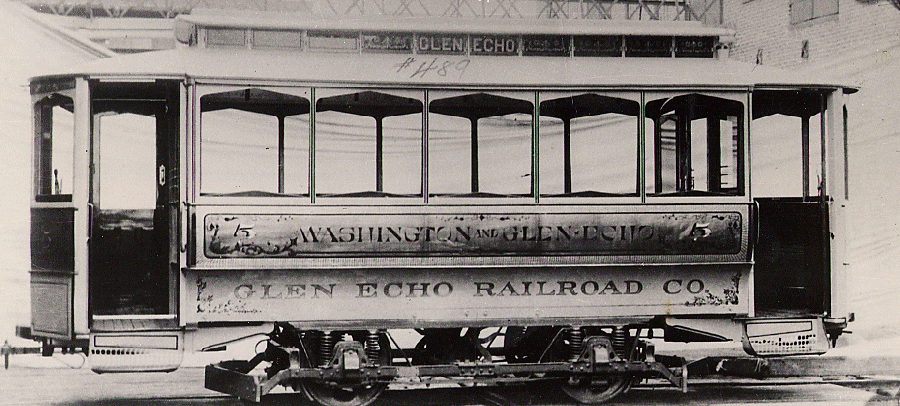
One of the original cars for the Glen Echo Railroad, car #5 has been repainted with the 'Washington & Glen Echo' name after the original line was bought out.
Trolleys and the Conduit Road
The first trolley line planned for Conduit Road was the Glen Echo Railroad Company. Started by the Baltzley brothers who founded Glen Echo and
three other men, the line began in Tennalley Town on Wissconsin Avenue at the Washington DC - Maryland line. The tracks ran throught the woods following
the present Willard Avenue. The tracks crossed River Road and continued down the least hilly terrain joining what is no Litle Falls Parkway about halfway
between River Road and the present Massachuetts Avenue. The tracks followed the course of the present parkway to just above Massachuetts Avenue where it
crossed Little Falls Branch on a tressle. The stone walls that supported the tressle can still be seen on both sides of the creek.
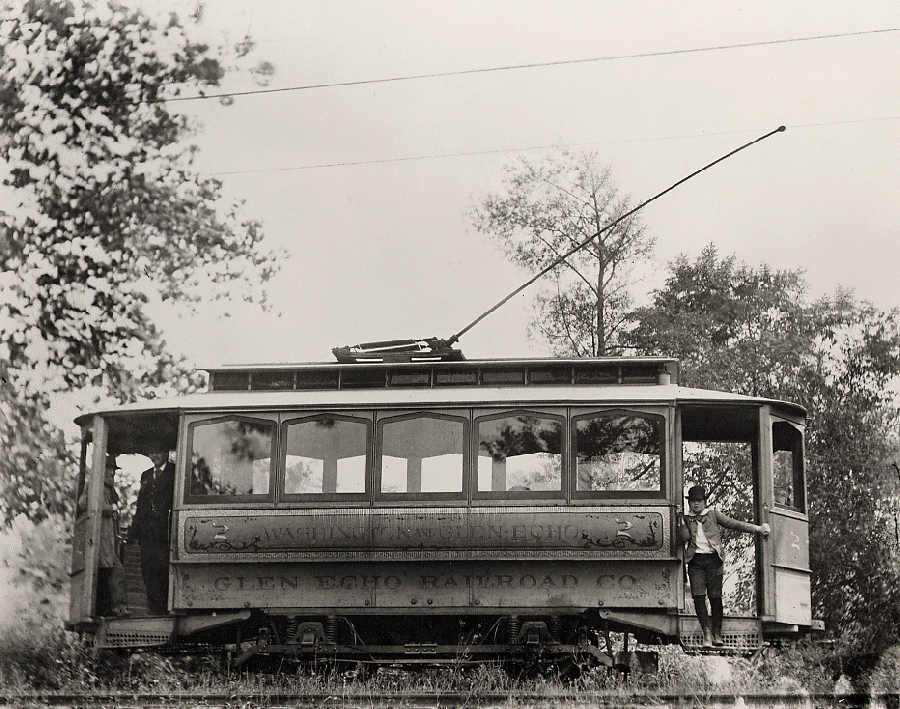
Car #2 near Willard Road near the Tennalytown end of the line
Trolleys and the Conduit Road
The Georgetown Branch line which blocks the original path of the trolley line was not yet built. The Georgetown Branch line is now the Capital
Crescent trail. The trolley line followed the present course of Massachuetts Avenue up to the location of the Glen Echo - Cabin John fire department,
where it forked off onto Walhonding Road. The line followed Walhonding for its full length ending ust short of Conduit Road (now MacArthur Boulevard).
The original plans called for the line to cross Conduit Road and parallel the road as far as the Glen Echo Chautauqua grounds, but the Baltzleys were
not able to get permission to cross the Conduit with their tracks.
The Trolley line was chartered in 1888, before the Baltzleys had decided to build a Chautuaqua at Glen Echo. They were building a complex of
structures to house a post office and stores to make their new suburban development more attractive. The trolley line was actually intended to reach
this complex.
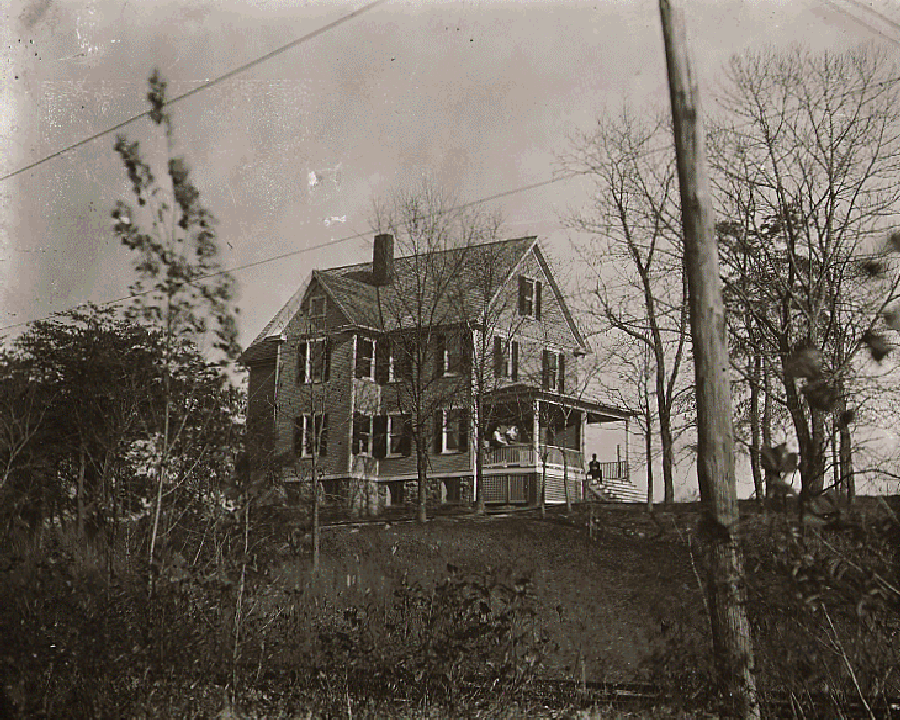
Trolley tracks run by the home of one of the men who sold land to the Baltzley's for right-of-way.
Trolleys and the Conduit Road
Trolley cars were purchased by the J. G. Brill company. Property along the right-of-way was purchased from a number of land owners, including a
Mr. Solyum whose house is shown on the right. The tracks of the trolley line can be seen in the foreground before the house. Two of the last visible
remains of the line can be found in Willard Park just off River Road, a 'frog' (part of a switchtrack) can be seen to the side of the dirt path, and a
footbridge now spans the creek over original tressle support walls. Several pieces of the original track are in a private collection, but no known track
remains along the route of the line.
The line opened for business on June 17th, 1891, a day late for the opening of the Glen Echo Chauauqua. Carriages carried riders the last short distance
to the Chautauqua.
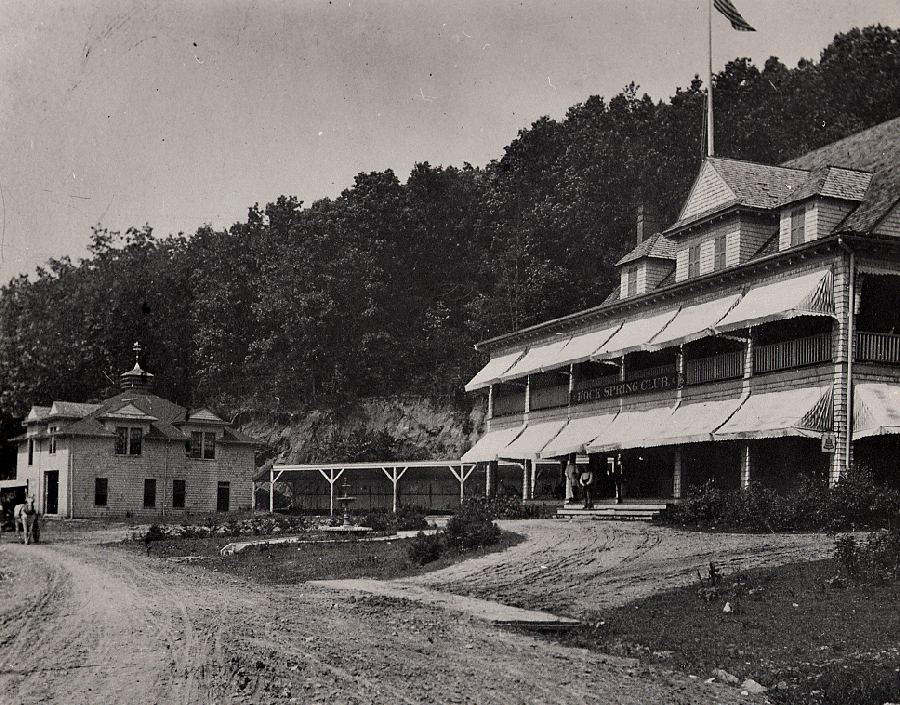
The Georgetown line ran past a number of road houses (read gambling & drinking), this is the Rock Spring Club on the conduit Road not far from the Glen Echo line carbarn
Trolleys and the Conduit Road
The line was well used in 1891 while the Chautauqua was in session. Ridership declined to a slow pace after the season. In early 1892, rumours of malaria at Glen Echo were rampant! Some blamed the rumours on a competing real estate company, but rumours had been growing since one of the Chautauqua teachers died of pneumonia shortly after the season ended. The 1892 Chautauqua season never started, dooming the trolley line to just commuter traffic.
The line continued as evidenced by an 1892 time schedule, but little is know of the day to day operation. The bookkeepping records of the line still exist and much could be learned from rigorous study of these.
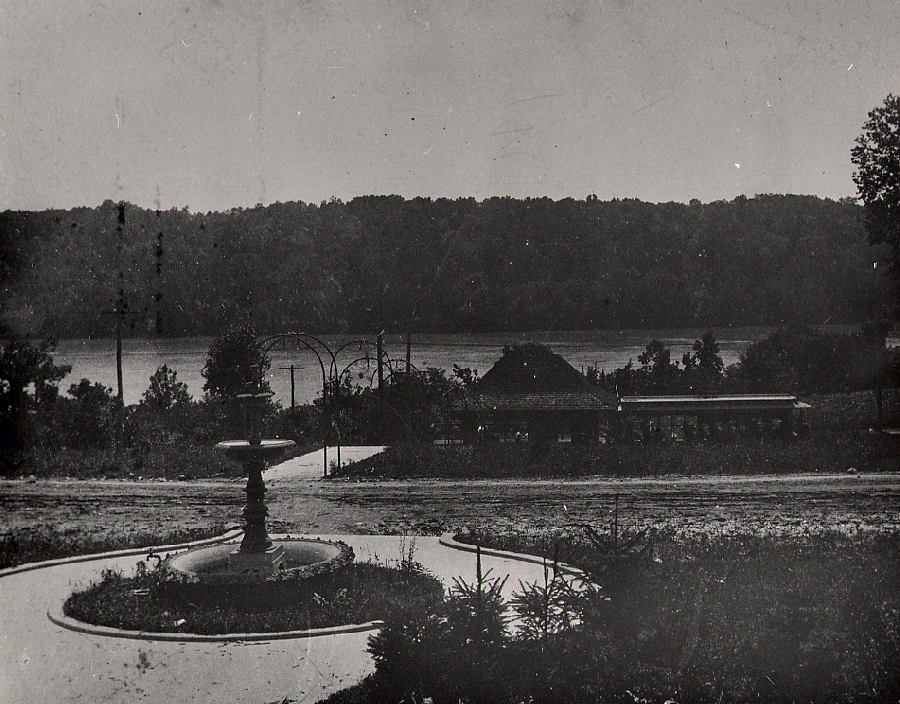
A view of the Georgetown line tracks in front of the Rock Spring Club
Trolleys and the Conduit Road
At the terminus of the line on Walhonding Road stood the powerhouse and carbarn for the Glen Echo line. The building was a massive two story granite structure built in a style very like the Glen Echo Chautauqua buildings.
The upper floor was on the same level as the tracks and housed the trolley cars when they were not in use. The lower floor housed the power plant. The power plant was built by Benjamin C. Pole, a business man with considerable power of pursuasion. Pole claimed that his power system produced more power than it consumed, Essentially a perpetual motion machine! His plant produced "Poleforcia", a product of his 'Multiple Energizing Momentum Engines'.

The Glen Echo Electric Railroad carbarn and power house, near the intersection of Walhonding Road and Conduit Road
Trolleys and the Conduit Road
It must be stated that Pole was not a complete charlitan, his engines were quite efficient for the time. The engines spun massive flywheels that kept a steady flow of electricity coming out of the dynamos which were driven by steam engines.
In 1896 the Baltzley brothers, along with several other investors, chartered the West Washington & Great Falls Electric Railroad with plans to build a line from Georgetown to Great Falls following a pathway between the Aqueduct the C & O Canal. Construction was started and reached Glen Echo sometime late in 1896 or early 1897 (reports differ). This left a stretch of less than 100 feet betewwn the end of the Glen Echo Railroad line and the new line along the Conduit Road.
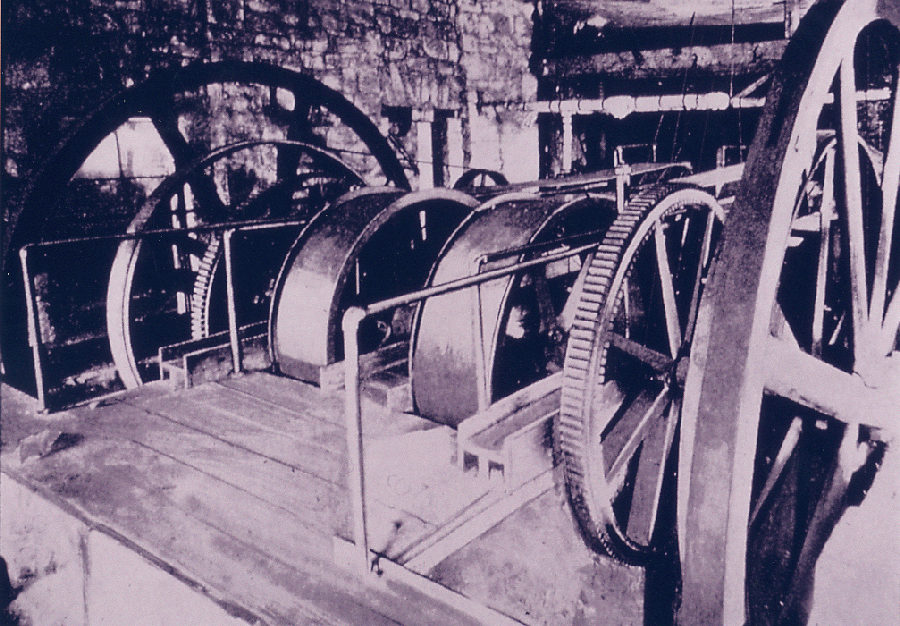
A portion of the massive steam-to-electric generating system in the lower part of the power house
Trolleys and the Conduit Road
The Baltzleys petitioned Congress for permission to cross the Aqueduct with the Glen Echo line and join it up to the Georgetown line (provision was made in the chartering of the Georgetown line for the connection), but the Army Corp of Engineers blocked the move due to the load it would put on the aqueduct.
There are conflicting stories about how the crossing was finally accomplished. An Act of Congress was passed in 1896 allowing the crossing, but Edwin Baltzley's daughter told a more interesting story.

Another view of the generators showing some of the flywheelse
Trolleys and the Conduit Road
Baltzley's daughter stated that her father had made the connection before Congress approved it. Edwin Baltzley looked into legislation about the aqueduct and found a loophole... He found that 'Existing Structures would not be dismantled' somewhere in the aqueduct rulings and decided that if he could make the crossing without being stopped it would constitute an "Existing Structure' and could not be dismantled.
The daughter further related that her father hired experienced trackmen from Philadelphia, had then brought down by train and had them build the connection in one night. If this is true it must have been quite an undertaking.

Caption - to be done
Trolleys and the Conduit Road
By late 1896 with the failure of the Glen Echo Chautauqua reducing ridership to near zero, the Baltzleys lost control of the line in a hostile take-over.
The line was renamed the Washington & Glen Echo Electric Railroad and extended from Tennaley Town to Chevy Chase Circle on Conneticut Avenue (This extension is the source of the frog in Willard Park).
Ridership further decreased with the opening of the Georgetown line and by 1900 the line was virtually closed. There are records of sporatic operation until 1902 when the line ceased operation.
The power system was removed and reused elsewhere in DC, the carbarn was abandoned and quickly fell into disrepair.

Caption - to be done
Trolleys and the Conduit Road
The tracks from the Glen Echo line were removed, most likely for scrap. By the late 1930's the carbarn was reduced to shattered ruins with few walls over 8 feet tall remaining. By the 1950's nearly all trace of the structure was gone.
During the late 1950's and early 1960's squatters lived on the site of the old carbarn, accounting for much of the old trash and debris that can be found on the slopes of the adjoining valley.
Two or three squared blocks from the corner of the carbarn in the yard of a home are all that remain today.
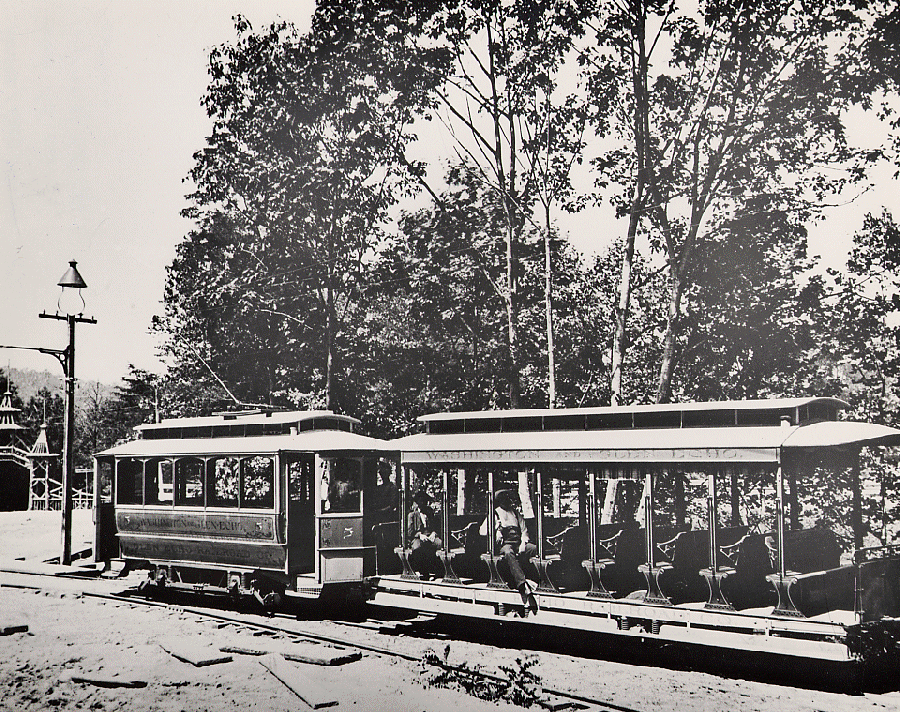
Caption - to be done
Trolleys and the Conduit Road
The Georgetown line remained in operation long after the old line through the woods was gone. In 1897, vaudeville came to Glen Echo in the old Chautauqua Ampitheatre. The trolley line brought visitors out to Glen Echo where they picniced in the afternoon berfore the performances started.
The Georgetowne line was eventually bought by the Washington Railway and Electric Company (WRECO). WRECO formed "The Glen Echo Company", leased the old Chautauqua property and sublet it for the next few years to various promoters who brought in everything from light-opera to prizefights.
Vaudeville was not a good fit for Glen Echo as some unsavory entertainments followed. Gambling booths were built in the woods near the ampitheatre and there were accusations of the games being rigged. Uncontrolled drinking along with the gambling gave Glen Echo a bad name.
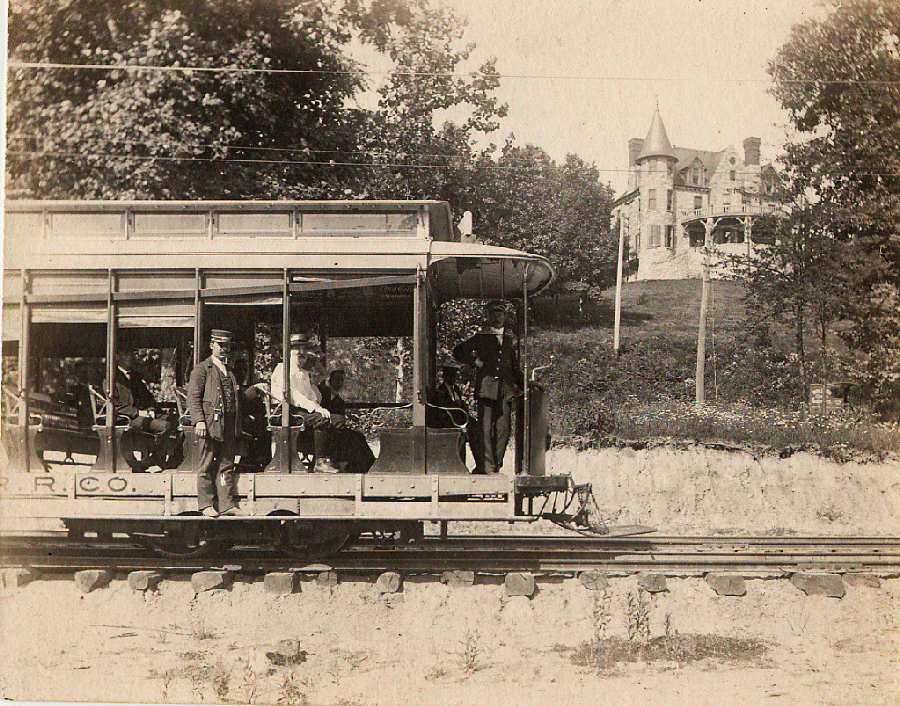
Caption - to be done
Trolleys and the Conduit Road
By 1899, Glen Echo began installing amusement rides, advertisements claimed "No spiritous Liquors, No Objectionable Activities" trying to live down the publicity of 1897.
The Glen Echo Company leased space to concessionaires, increasing the number of features at the park. Pony rides and bowling were offered by 1900, along with carrousel rides. The carrousel may have been a small 1876 Dentzel portable carrousel that was at one time on the grounds of the Cabin John Bridge Hotel.
By 1900 Glen Echo was attracting many visitors, most of whom came on the trolley.

Caption - to be done
Trolleys and the Conduit Road
The trolley line passed the home originally built for Edward Baltzley, but by then inhabited by his brother Edwin and his family. The Baltzley house can be see in the photo above and to the right.
For much of its length, the line paralleled Conduit Road. The road and the parallel trolley line can be seen in the photo to the right.
During the summer months, the line ran "open cars", these cars had two rows of seats with an asile down the middle, but no sides whatever. A careless rider could simply fall out of the running train if not careful. The conductors normally collected tickets by walking along the running board on the outside of the cars.

Caption - to be done
Trolleys and the Conduit Road
The photo to the right shows an open car. It is likely that the car was stopped for this photo as riders would not normally be allowed to stand on the running board
In the background behind the car is a section of Chautauqua fencing. This puts the car somewhere between the old Sycamore Story (near the Glen Echo Railroad carbarn) and the Chautauqua grounds.
For much of its length the line ran through wooded areas but with a good open view of the Potomac River. Over the years the trees between the C & O Canal and the trolley line grew and by the early 1960's when the line ceased operation, the river was only ocassionally spotted between the trees.

Caption - to be done
Trolleys and the Conduit Road
Running along the Potomac River meant that the line crossed a number of tributary streams, requiring numerous tressles to carry the tracks over the water. One of the larger tressles was over Little Falls Creek. One tressle between Glen Echo and the Cabin John Bridge simply spanned a dry valley.
Several of the old tressles are still standing, though they are in very poor shape and are carefully fenced off to protect would-be-adventurers. One of the best views can be seen by parking in the lot by the old Sycamore Store and walking down the path to the C & O Canal. On this path you will pass under one of the tressles.

Caption - to be done
Trolleys and the Conduit Road
The line ended in different places at variuos times. The 1896 tracks made it all the way to the Cabin John Bridge, but in the first 10-15 years of operation, sometimes the trolleys did not run past the park. An early map shows the tracks looping around on the old Chautauqua grounds.
But for most of its operation the line turned around right next to the Cabin John Bridge. The Cabin John loop can be seen in the photo to the right.
The land for the Cabin John loop was conditionally deeded to the trolley company by the Bobinger Family (operators of the famous Cabin John Bridge Hotel). The deed stipulated that if the property failed to be used as a public utility for a certain period, ownership reverted to the Bobinger family or heirs.
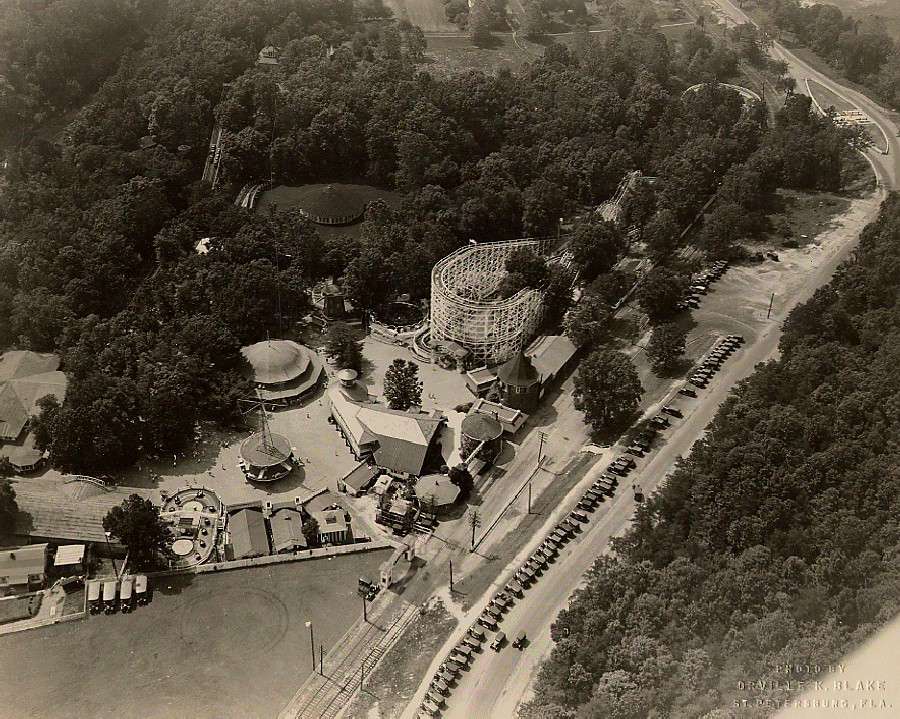
Caption - to be done
Trolleys and the Conduit Road
By about 1904 Glen Echo PArk was a full fledged amusement park and the trolley was the favorite way to arrive. Trolley lines and amusement parks have an historic association. To meet peak commuter needs during the work week the companies had to have high capacity electric generation capabilities; but in the evenings and on weekends they had excess capacity. Amusement parks were basically electricity hogs with their electric motor driven rides and thousands of bright carnival atmosphere lights.
By 1900, most of the amusement parks in the United States were at or near the end of a trolley line, not only using the line's excess electricity, but making money by increasing ridership on the weekends.

Caption - to be done
Trolleys and the Conduit Road
Glen Echo was no exception, in 1903 WRECO bought the Glen Echo property when the Baltzleys finally lost control of the site due to their inability to meet mortgage payments. WRECO cought the entire site for $13,000 - a fraction of the cost the Baltzleys spent improving the site.
WRECO continued to lease out the property until the end of the 1910 season. In 1911 the reopened the park with a manager who worked directly for their new subsidary, The Glen Echo Park Company.
WRECO became park to Capital Transit in 1933. This year marked the consolidation of most of the trolley companies in DC. Capital Transit began their new business by instituting "Weekly Passes" which entitled the holder to unlimited rides on their lines for one week from Midnight on Saturday Night.
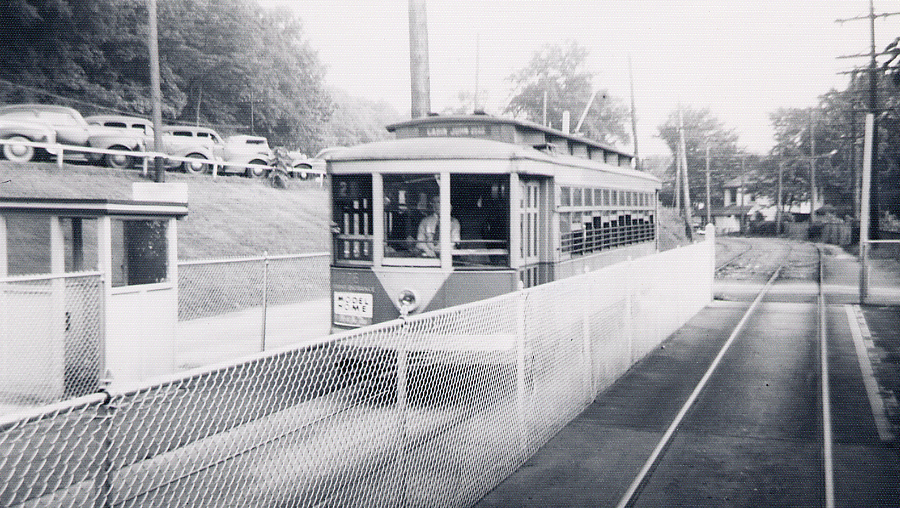
Caption - to be done
Trolleys and the Conduit Road
Many DC youths realized this was an easy way to get to Glen Echo by offering to "pick up" a family member or neighbor's pass at the Capital Transit offices and then use the pass to ride to Glen Echo before turning the pass over to its owner. Sometimes with, but often without the owner's knowledge.
The depression did not seriously impact Glen Echo Park's business. By the 1930's Glen Echo Park was attracting around 10,000 visitors on a normal weekend; most came by trolley.

Caption - to be done
Trolleys and the Conduit Road
The 1940's were the busiest years for Glen Echo Park, during the war Glen Echo was a favorite haunt for servicemen. Many local girls came out to the park hoping that they could brighten the evening of a lonely serviceman, and get a free admission to the evening dance in the ballroom too.
However, after the war ended, many more people were buying their own cars. The peak days of the trolley ridership to the park were past. The pleasant ride out the Conduit Road in a car was stiff competition to a stuffy old trolley car.
But the trolley ran on...
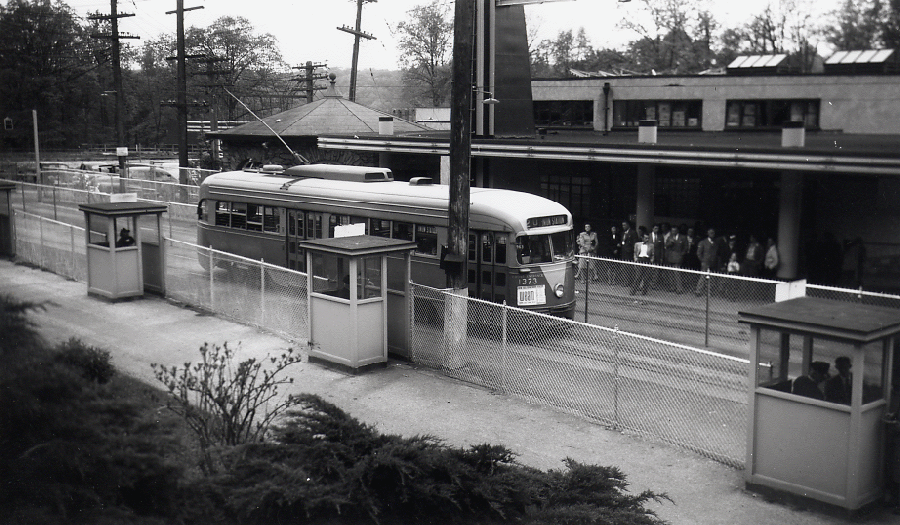
Caption - to be done
Trolleys and the Conduit Road
The ride from Georgetown to Cabin John was a wonderful adventure for a child. Weaving through the trees, glimpses of the River, a hawk circling overhead, and the lullaby of the regular click of wheel-on-track. A great number fo Washingtonians have fond memories of the old Cabin John line.
In 1956 the Amusement Park decided that they did not have enough parking. Cars were taking over, and the park tore down the old Chautauqua Ampitheatre and built a large parking lot. Hundreds of cars filled the lot and trolley ridership dropped even further.
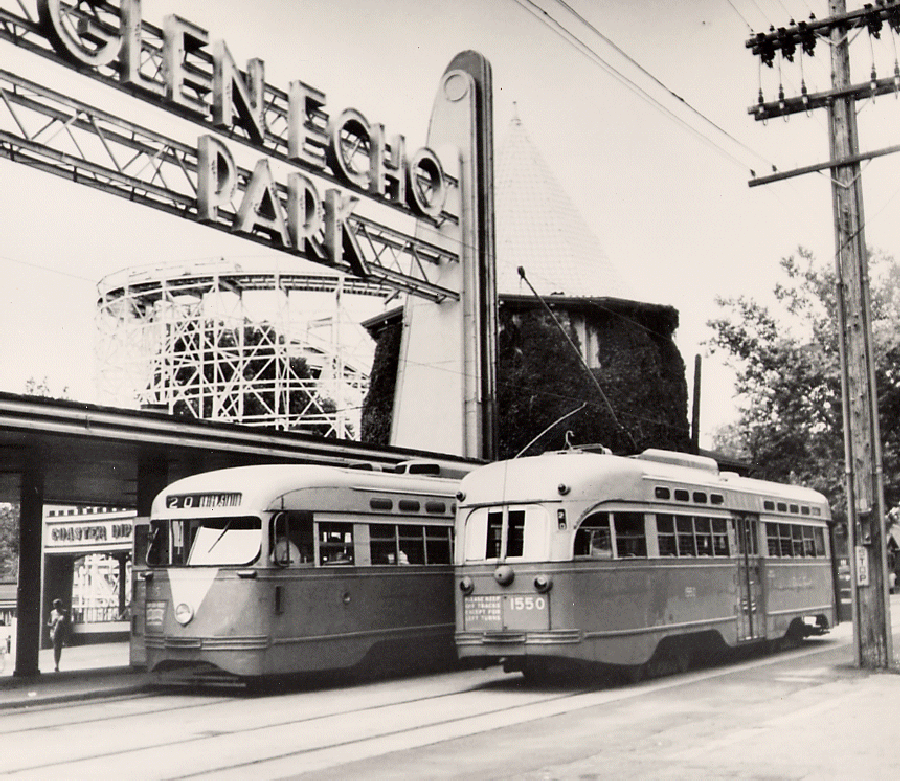
Caption - to be done
Trolleys and the Conduit Road
In 1956 the fate of Trolleys in Washington DC was sealed. Congress revoked the charter of Capital Transit in a move that has been regretted by many for decades. Many later reports implied that a major bus manufacturer had exerted influence over several key decision-makers, resulting in a decision to end trolley lines and replace them with busses.
DC Transit began operation in September 1956 with a requirement that they eliminate trolley use within seven years.
The last trolley to Cabin John ran on January 3, 1960; the last of the Washington trolley lines closed in 1962, a full year before the required date.

Caption - to be done
Trolleys and the Conduit Road
The end of trolley service to Glen Echo and Cabin John was a sad day for many. The relatively recent addition of a trolley car in front of Glen Echo Park is a reminder of happier transportation days.
|
|




